| Columns Retired Columns & Blogs |
A frightening thought:
Can Pass whip up a 6 or 8 channel version of this?
I measured the Pass Laboratories XP-32's performance with my Audio Precision SYS2722 system (see the January 2008 "As We See It"), repeating some tests with the magazine's more-recent APx555 system. The maximum gain was a little higher than the specified 9.6dB for the balanced and unbalanced inputs to the balanced outputs, at 10.2dB. The gain from the unbalanced input to the unbalanced output was 6.5dB. The preamplifier preserved absolute polarity (ie, was noninverting) with both balanced and unbalanced inputs and outputs. (Its XLR jacks are wired with pin 2 hot, the AES convention.)
The XP-32's unbalanced input impedance was close to specification at 20Hz and 1kHz, at 20.3k ohms, but slightly lower at 20kHz, at 17.6k ohms. The balanced input impedance was to specification and twice the unbalanced, as expected. The unbalanced output impedance was a low 38 ohms at 20Hz, and 32 ohms at 1kHz and 20kHz. The balanced output impedance was twice the unbalanced, again as expected, as there are two single-ended stages in series for this output.
The preamplifier's frequency response into high impedances was flat from 10Hz to 20kHz (fig.1, blue and red traces) in both balanced and unbalanced modes, with the ultrasonic rolloff reaching –1dB just above 100kHz. While the XP-30's low frequencies rolled off into 600 ohms, reaching –6dB at 32Hz (footnote 1), the XP-32's response into this demanding load was flat down to 20Hz (fig.1, cyan, magenta traces). Fig.1 was taken with the XP-32's volume control at its maximum setting of "199." Both the frequency response and the superb channel matching were preserved at lower settings of the control. The volume control operated in accurate 0.5dB steps for almost its entire range of operation.
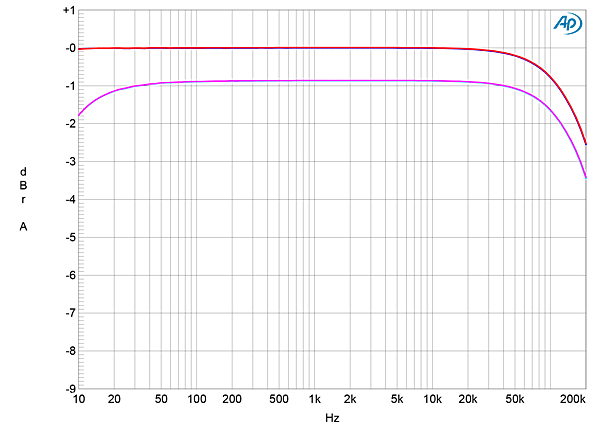
As you'd expect from the use of separate chassis for each channel, the Pass Labs preamp's crosstalk was superbly low, at –130dB in both directions below 1kHz, and decreasing only slightly, to –120dB at the top of the audioband (not shown). From balanced inputs to balanced output, the XP-32 offered extremely low noise, with no power supply–related spuriae in its output even with the two preamplifier chassis sitting on top of the separate power supply/control unit (fig.2). The wideband, unweighted signal/noise ratio, measured with the unbalanced input shorted to ground but the volume control set to its maximum, was a high 85dB ref. 1V output (average of both channels, which were very similar). Restricting the measurement bandwidth to the audioband increased the S/N to an excellent 94.5dB, while switching an A-weighting filter into circuit further improved this ratio, to 97.2dB.
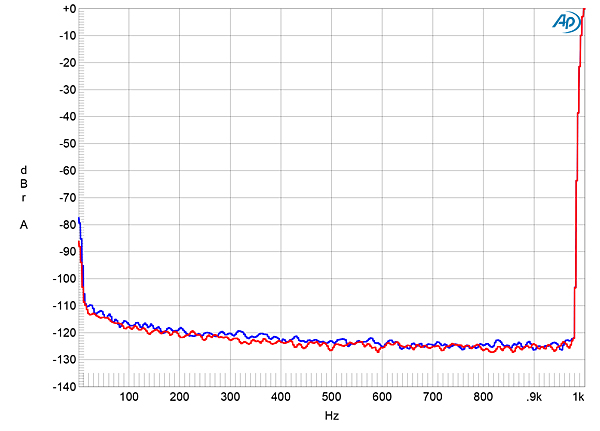
Figs.3 and 4 respectively plot the percentage of THD+noise in the XP-32's balanced output against the output voltage into 100k ohms and 600 ohms. We usually specify a preamplifier's clipping voltage as being when the THD+N reaches 1%. However, as you can see from this graph, the output voltage stops rising when the THD+N reaches 0.2%. The XP-32's balanced output level at this THD percentage was just below 30V, even into 600 ohms, which is almost an order of magnitude above the maximum level the preamplifier will be asked to deliver in typical use.
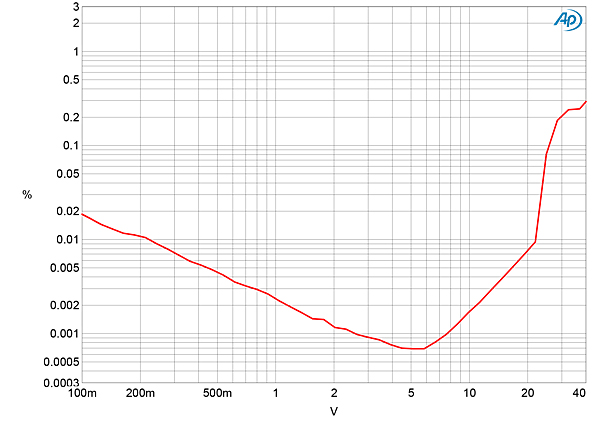
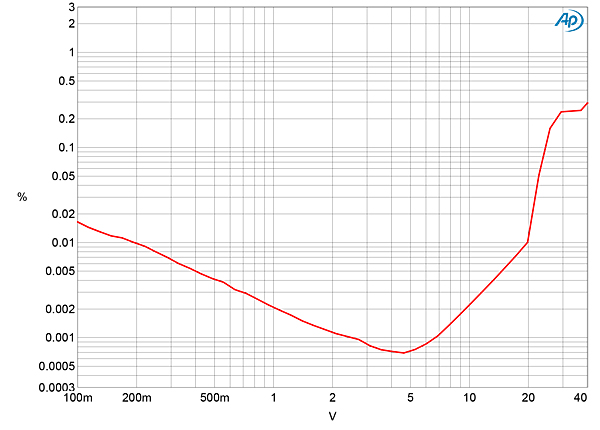
The THD+N was extremely low at output levels of a few volts, so to be sure that the reading was not dominated by noise, I measured how the XP-32's distortion changed with frequency at 4V. The THD+N percentage was extremely low throughout the audioband into both 100k ohm and 600 ohm loads (fig.5), though with a slight increase in the top audio octaves. I looked at the spectrum of the distortion at a similarly high output level because, at 1V, no distortion harmonics were visible above the noise floor. The result is shown in fig.6; the only harmonic that can be seen is the third harmonic at –114dB (0.0002%). This harmonic rose by only a couple of dB into the current-hungry 600 ohm load. Tested for intermodulation distortion with an equal mix of 19 and 20kHz tones at the same peak voltage level, the second-order difference product at 1kHz lay below –130dB, and the higher-order products were all below –110dB (0.0003%) (fig.7).
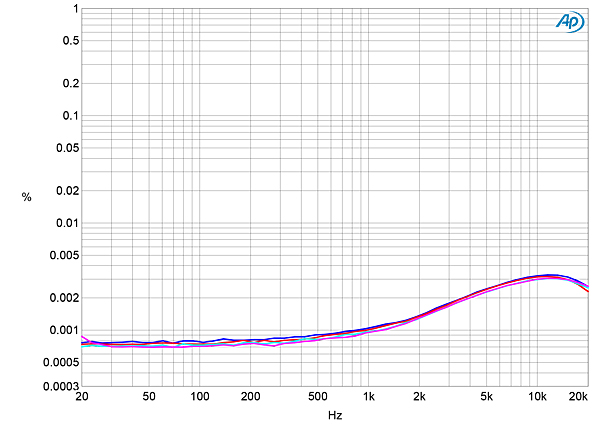
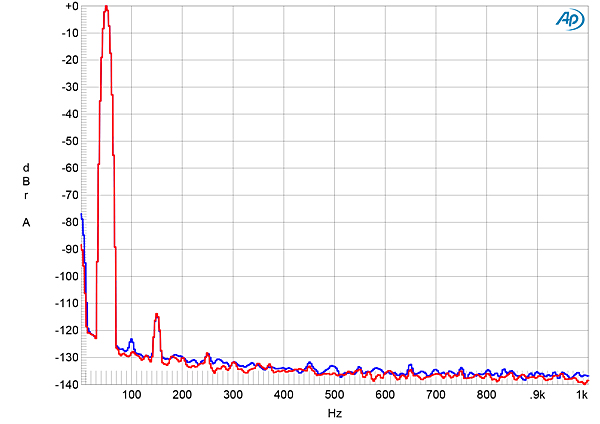
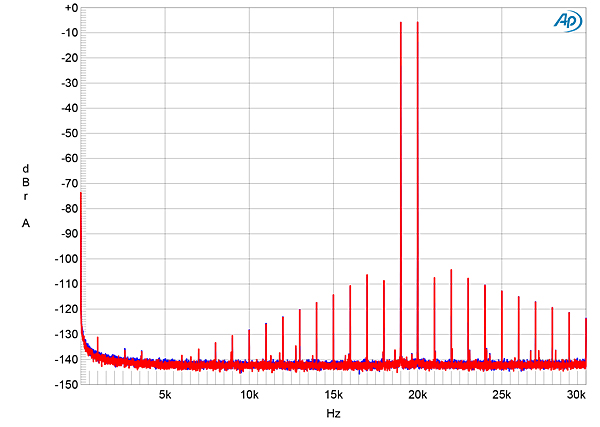
The XP-32 offered superb measured performance, better than that of the XP-30 and the more recent, two-chassis XP-22.—John Atkinson

A frightening thought:
Can Pass whip up a 6 or 8 channel version of this?

Can Pass whip up a 6 or 8 channel version of this?
I believe you can add additional audio-channel chassis, each controlled by the same control unit.
John Atkinson
Technical Editor, Stereophile

John Atkinson wrote: I believe you can add additional audio-channel chassis, each controlled by the same control unit.
I was really thinking of the price tag and the rack space.

Didn't a prominent Stereophile editor once say that it was the preamp that was the most important part of a system?
;-D
It's out of my budget, but I love Nelson Pass.

I think Wayne Colburn does those.

Hm, I see Sonus Faber Lumina III used as speakers during the review. Does that mean we can expect the Lumina's to be reviewed sometime in near future? :)

Hm, I see Sonus Faber Lumina III used as speakers during the review. Does that mean we can expect the Lumina's to be reviewed sometime in near future? :)
My review of the Lumina III will be published in the April issue of Stereophile.
John Atkinson
Technical Editor, Stereophile

It's a pity that stereophile didn't review the SF sonetto line so we could make a direct comparison between both lines. However it's still good news to hear :)

Didn't you say that you returned it? Did you have to purchase it or is it on long term loan?
After I measured the MBL N11 for Jason's review, I arranged to hold on to the preamplifier first to use in my followup review of the MBL N31 CD player/DAC in the December 2020 issue, then to use as a reference for this Pass Labs review. It has since been shipped to another Stereophile reviewer to use as a reference for a review of another product.
John Atkinson
Technical Editor, Stereophile

I once connected my Wadia 781 directly to my power amplifiers (Pass X 600). The sound is much better with my preamplifier (Audio Research Ref 5) in between!

I know what you mean:
I once connected my Wadia 781 directly to my power amplifiers (Pass X 600). The sound is much better with my preamplifier (Audio Research Ref 5) in between!
I gave up on finding a suitable preamp since I need 8 channels. I run my DACs directly to my power amps and it is, indeed, much better.

I have some trouble looking at the signal to noise specs. The claim is 150 dB at max output voltage, and 500 nV residual noise, which is more or less what you expect with an output voltage of 23V and 150 dB S/N.
However JA measured 85 dB at 1 V. At 23 V we should then expect 27 dB more which is 112 dB, a whopping 38 dB less (a factor of 80). This would result in a residual noise of 56 mV, more than a factor of 100 higher, Even with bandwidth restriction and A-weighting the measured S/N reaches "only" 124 dB, 26 dB less than claimed.

The SN ratio was calculated from max output of 32 Volts with 1uV as the noise. The noise floor is actually lower than 1uV. It all depends how you measure it and the reference. Of course we spec it to look good, the suns output would make a good max reference. Measured on the AP with a 30 KhZ filter it is about 14 uV broadband. John's AP FFT show -120 to -140 dB range. 56 mV would be rather crappy, its a very quiet preamp.

Aah, there is a typo on the specification page: 23 V max (correct is 32 V). So my calculations are 3 dB off.
14 uV noise broadband (30 kHz) is almost 30 times more than the specified 0.5 uV. May I ask under which conditions you did measure those 0.5 uV?
Regarding JA's FFT plot: one have to keep in mind that the FFT noise floor does not show the S/N value. You have to subtract the FFT gain (3dB per doubling of bin size) to get the real value. I don't know the FFT size of JA's FFT plot. With 16k FFT size the FFT gain is 39 dB. Subtracting 39 dB from 120 - 140 dB we get 81 - 101 dB which correlates quite well with JA's measured S/N.

I hope you don't mind if I point out that your turntable setup is perhaps getting a bit long in the tooth? I love the Linn and all that but at lot has happened since 1991 even in Linn world. That old MDF tone arm board is not exactly known for it's high resolving power. Could it be that your digital setup is outresolving your turntable in the time domain and perhaps that would not be the case with a modern turntable or even an up to date Linn?

I hope you don't mind if I point out that your turntable setup is perhaps getting a bit long in the tooth? I love the Linn and all that but at lot has happened since 1991 even in Linn world...
Indeed it has, but I am so familiar, so comfortable, with the sound of my LP12-based LP system that I fear change.
John Atkinson
Technical Editor, Stereophile

Why on earth would you not want to run the pre Amp Direct , favoring the sound of caps maybe ..??
Btw JA ,
Are those stereophile CD’s mentioned still available ..??
Regards

Are those stereophile CD’s mentioned still available ..??
Yes, see http://shop.stereophile.com/music-cds/
John Atkinson
Technical Editor, Stereophile

Looking at my test CDs, I found, with no jewel box, cover art, or record of purchase, Stereophile CD STPH-002-2. It was apparently the first test CD Stereophile made, released in 1990.

I suggest a follow up to address those coupling caps.
"The output is still capacitor-coupled even with the servo but can be bypassed with internal jumpers."
On the back panel - "no user serviceable parts"
Question for Wayne - why not have jumpers accessible to the exterior? Note all those XLR jack jumpers/
(good photos BTW)